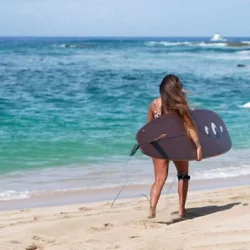
(HONOLULU) — For 26-year-old Ha’a Keaulana, surfing is practically part of her DNA. She’s been around surfing since she was a baby, even before she could walk or talk. Some of her first memories were being a surfboard with her grandfather, Hawaiian surfing legend, Buffalo Keaulana.
“He was raised in a time where a lot of our culture got taken away,” Keaulana told ABC News. “You weren’t allowed to speak our language. And sometimes, some people couldn’t even hula dance. And so that got lost. So I think naturally, he just always connected to his culture through being a waterman in the ocean.”
Keaulana represents a growing movement of native Hawaiians celebrating and reclaiming the cultural spirit of surfing that they say has been commercialized and coopted by pop culture over the last century.
“[Surfing is] our church, because that’s where we spiritually can connect to something that was always there as native Hawaiians. I feel connected to my ancestors. I feel connected to my culture,” Keaulana said.
While films like “Point Break” and “Surfer, Dude” along with music like the Beach Boys’ hit song “Surfin’ USA” are examples of a modern portrayal of the sport that tie it more to California, drawings from Western explorers in the 1700s and 1800s show that surfing traces its roots back to ancient Hawaii, according to the Bishop Museum in Honolulu.
“There’s these accounts where they’re like people would do these death defying acts on these pieces of wood in waves that sailors were terrified of. The water men of the west would never even attempt it. And these are like young women doing it. And it just blew their minds, literally,” said Michael Wilson, the museum’s surfing exhibit designer.
The mass arrival of Westerners in the 1800s challenged the native indigenous cultures. As many Hawaiians went to work in the sugar cane fields, surfing dwindled, until one man came along over 100 years later – Native Hawaiian Duke Kahanamoku – a three-time swimming champion in the 1912 and 1920 Olympics. Kahanamoku promoted Hawaii and surfing while traveling the globe, Wilson said.
Over the following decades, a new generation of Hawaiian surfers emerged, including legends like brothers Clyde and Eddie Aikau, who were the first lifeguards in O’ahu’s Waimea Bay.
“We never lost one person in 10 years…We didn’t have any jet skis. All we had was fins and a surfboard,” Clyde Aikau said.
Eddie Aikau was lost at sea trying to save his friends after their voyaging canoe the Hokule’a capsized in the open ocean, according to the Eddie Aikau Foundation. An invitational surfing competition in O’ahu’s north shore was named in his honor.
Clyde Aikau says surfing is sacred place for Hawaiians to go for peace of mind, but the culture has since turned into big business. Surfing as an industry is estimated to be worth over $4 billion, but Clyde Aaiku doesn’t believe that money ends up benefiting Hawaiians. When asked by ABC News how much of that financial boon he believes native Hawaiians benefit from his answer was “zero.”
Still, some Hawaiians are riding the wave of surfing’s future, such as surfing champion Carissa Moore. A native Hawaiian, she took home the gold medal at the 2020 Tokyo Olympics during the sport’s debut. She’s now taking her place next to Duke Kahanamoku in surfing history and inspiring a new generation of surfers in Hawaii.
“It was a really huge deal to Native Hawaiians that Carissa brought home the gold. And we are so proud of her,” Keaulana said.
Copyright © 2023, ABC Audio. All rights reserved.






